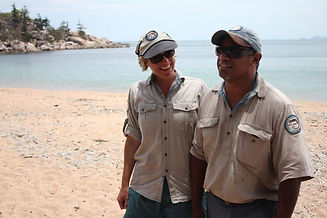Wulgurukaba - Our Traditional Ownwers of Yunbenun
Indigenous cultural sites on the Magnetic Island (Yunbenun) have been recorded by the Wulgurukaba people, or in partnership with staff and other professionals from the NQ Dry Tropics, Northern Archaeology Consultancy, James Cook University (JCU) and Queensland Parks and Wildlife Services (QPWS) amongst others.
A lot of this information is kept on cultural heritage databases maintained by the State, QPWS and NQ Dry Tropics.

Significant Sites in Arcadia
There are at least two important art sites in Arcadia and a significant midden site located next to a spring/waterhole on a major freshwater creek in the area. Bryan and Lyle Johnson (Wulgurukaba) give us a few insights about the hidden indigenous stories of Arcadia.
Photo: Wulgurukaba Traditional Owners Brian Johnson and Lyle Johnson at Alma Bay, March 2019.


1. MIDDEN SITES
(Midden: Where the debris from eating shellfish and other food has accumulated over time)
"This site contains oyster, pipi and mud mussel shell remains and stone tools. Because of the freshwater it would have been ideal for camping and could also have been a stopover point on a walking track connecting Arcadia to the western side of the Island.
Florence Bay is also a very inhabitable area because of the depth of middens. You can tell from midden sites and art sites how long people have lived here."
An example of a midden. Photo courtesy of Care For Country.
2. WORKING SITES
"IT'S A LIVING SITE, PEOPLE CONGREGATED THERE"
"Between Petersen Creek and Bremner Point was a perfect place to camp. In the rocks near Alma Bay, there’s a working area - a knapping site where people chipped away at stones to get spear points and shaped tools for domestic use.
In terms of the cultural landscape and how it connects to other bays, Arcadia is the entrance to the main quarry site at the top of the hills behind Arcadia.
Arcadia is a gateway for a vast amount of tools that people needed."

Photo courtesy of https://www.aboriginalheritage.tas.gov.au

3. GABUL CREATION STORY
"It’s ok to tell the Gabul story now. Gabul refers to the Wulgurukaba Dreaming story of how the islands off the Townsville coast were formed.
According to the Dreaming, Gabul was a giant carpet python who carved the landscape while travelling from Herbert River, through the Palm Island Group, up Ross River and coming to rest at Magnetic Island.
Gabul’s head can still be seen in the Arcadia headland. The head of Gabul represented at Alma Bay highlights the importance of the area.
The Gabul story connects Yunbenun to Wulgurukaba country on the mainland particularly through the Ross River and to other Aboriginal groups to our north particularly the Manbarra, the custodians of the Palm Island group of Islands."
Photo: A sign on the ethno-botanical trail at Garabarra (Kissing Point, Townsville) provides more information on the Gabul creation story.
4. WATERHOLES
"There are waterholes dug into rocks up the back (Bremner Point); to go to that length, our people must have been here a long time.
We’re still here and we’re surviving on this country. On the lowlands, a lot of stuff has been cleared and built over the top of. Wayne Wilson’s grandmother said there were caves all up the back here under the bus route (near Gabul Way); then add two art sites at Arcadia.
With the reef in Geoffrey Bay, there is more variety of resources."
Photo: Wulgurukaba turtle nesting artwork on the Geoffrey Bay Foreshore.



Photos: (Left) Follow the signs for a great bush tucker adventure when you're visiting Pallaranda and Saunders Beach. (Right) Green ants are high in protein and are still widely used by indigenous Australians to combat coughs and colds. Photo by @ochrerestaurant
BUSH TUCKER TRAILS
"Down the track we are considering creating a bush tucker trail similar to the Wulgurukaba trails at Pallarenda and Saunders Beach with Latin, common and Wulgurukaba names.
Russel Butler (Bindal) also did some work at the Palmetum. Geoffrey Bay would be a good site for interpretation or where there are existing bush food/medicine plants."
> READ: 5 Bush tucker foods and how to find them (Queensland Uncovered)

> LISTEN to the 2010 ABC Radio North Queensland interview by Nathalie Fernbach with Ranger and Wulgurukaba elder Brian Johnson as he talks about the Wulgurukaba on Magnetic Island.


Working together
In order to replenish the system the government and other groups have put in protection including the green zones at Geoffrey Bay and Alma Bay, which the Wulgurukaba agree with.
"We all work in partnership with all the groups looking after country: Geoffrey Bay Coastcare, Parks, MINCA, NQ Dry Tropics. We’ll work with anybody and everybody who wants to keep the place good.
We worked with Geoffrey Bay Coastcare on the rubber vine project, yellow oleander, turtle nesting. We’re trying to work together to the same goal."
Photo: Marine Park Rangers Jo Petersen and Troy Johnson work with ACC and other groups on projects that maintain Magnetic Island's Natural assets. Photo courtesy of ABC North Queensland.
REPORTS
-
Nick Hymes’s Native Title Report
-
Michelle Bird and Liz Hatte
-
Nancy Williams work documents the written and oral history
Other earlier reports can be located at the Institute of Indigenous Studies Library in Canberra.